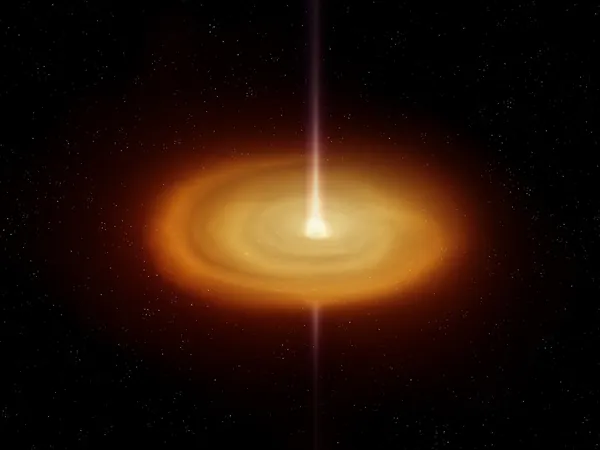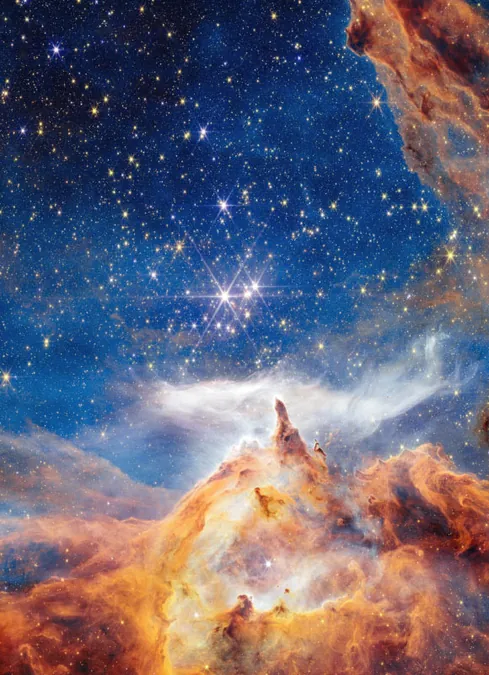
Unlocking the Mysteries of Star Formation: ALMA's Stunning Discovery in the Distant Milky Way
2025-09-05
Author: John Tan
Astronomers Unveil Star Formation Secrets in Remote Galaxy Regions
A groundbreaking discovery is reshaping our understanding of star formation in some of the galaxy’s furthest reaches. Thanks to the powerful Atacama Large Millimeter/submillimeter Array (ALMA) in Chile, scientists have captured the first-ever spatially resolved images of protostellar outflows and jets in the outer disk of the Milky Way.
Discovering Protostellar Activity 26,000 Light-Years Away
Focusing on the protostellar source Sh 2-283-1a SMM1, located about 26,000 light-years from Earth and more than 51,000 light-years from the Galactic Center, researchers have stumbled upon a treasure trove of insights. This fascinating region is unique, containing only a third of the heavy elements found near the Sun, providing a rare opportunity to study star formation in low-metallicity environments akin to those of the early Milky Way.
Stellar Jets: Pulsing Like a Heartbeat
ALMA’s high-resolution imaging unveiled a captivating bipolar structure: narrow, high-speed jets shooting away from the protostar, enveloped by slower, broader outflows. This mapping allowed scientists to track gas movements with unprecedented clarity over such vast distances. The revelation that these jets are episodic—bursting every 900 to 4,000 years—shifts our perception of stellar growth, as this rhythm helps young stars keep collecting matter while shedding excess.
Revolutionizing Our View of Stellar Birth
Although episodic outflows have been observed in nearby star-forming regions, this is the first instance of such behavior detected in a protostar located over 15 kiloparsecs from the Galactic Center. This suggests that the core processes of star formation are consistent across different environments, even where surrounding chemistry varies dramatically.
Chemical Signatures of the Galaxy's Outskirts
However, the chemistry within Sh 2-283-1a SMM1 tells a different tale. Measurements of carbon monoxide (CO) and silicon monoxide (SiO) showed unusually low ratios, indicating a distinct shock chemistry and dust characteristics within this outer galaxy locale, reflecting its heavy element scarcity. This protostar has also been classified as a ‘hot core,’ a warm, chemically rich region that suggests the presence of complex organic molecules.
Expanding the Horizons of Star Formation Research
ALMA’s observations didn’t stop there; the instrument also detected molecular outflows from four additional sources in these remote regions, demonstrating that star formation is not only active but widespread. This expansion of research to the outer Milky Way allows astronomers to test historical models of stellar birth under primitive conditions reminiscent of the early Universe, when heavy elements were few.
Looking Ahead: Future Research and Implications
The research team aims to broaden its survey of protostars in the Milky Way’s outskirts. By comparing episodic jet cycles and molecular compositions across different environments, scientists seek to understand how metallicity influences the rhythm and chemistry of star formation. This exploration may also lay the groundwork for how planetary systems could emerge in chemically diverse settings.
A Universal Blueprint for Star Formation
This pivotal study underscores that while the chemistry of star formation varies by environment, the fundamental physics remain unchanged throughout the Milky Way. In essence, from our cosmic neighborhood to the ancient outskirts of the galaxy, the blueprint for star birth is universal.



 Brasil (PT)
Brasil (PT)
 Canada (EN)
Canada (EN)
 Chile (ES)
Chile (ES)
 Česko (CS)
Česko (CS)
 대한민국 (KO)
대한민국 (KO)
 España (ES)
España (ES)
 France (FR)
France (FR)
 Hong Kong (EN)
Hong Kong (EN)
 Italia (IT)
Italia (IT)
 日本 (JA)
日本 (JA)
 Magyarország (HU)
Magyarország (HU)
 Norge (NO)
Norge (NO)
 Polska (PL)
Polska (PL)
 Schweiz (DE)
Schweiz (DE)
 Singapore (EN)
Singapore (EN)
 Sverige (SV)
Sverige (SV)
 Suomi (FI)
Suomi (FI)
 Türkiye (TR)
Türkiye (TR)
 الإمارات العربية المتحدة (AR)
الإمارات العربية المتحدة (AR)